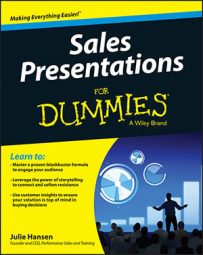Your sales presentation needs to build a persuasive case for the value of your product or service that resonates with your prospect. How do you determine what value to build your presentation around? In the planning process you uncover a lot of valuable information that you can now start to apply, including:
Impact: Impact answers how the problem is currently affecting your prospect or his organization and how your solution can resolve it. The ability of your solution to solve your prospect's business problem is the keystone of your value proposition. For example, a hospital is experiencing a rise in administrative costs because many of its processes are still done manually. It would like to cut its administrative costs by 10 percent. The impact is the rise in administrative costs.
Facts and figures: In order to quantify the value of your solution, you need to find out some costs associated with the problem. For example, assume that you were able to find out that the hospital has 300 employees involved in administrative jobs at an average of $20/hour. You estimate that your solution can save each employee three hours a week. During 50 employee weeks that is the equivalent of $900,000 in savings.
If you're unable to get specific figures from your prospect, you can look for similar clients, case studies, or industry statistics to give you direction and make your best educated guess.
Goals: Most companies use some type of KPI to track and assess their business processes. To ensure that you're in synch with your prospect, express their value in the terms that they use. For example, the hospital expressed its goal in terms of a percentage; therefore, you would convert $900,000 to a percentage of the known administrative costs, which equals 10 percent per year.
Competitive advantage: Where do you outperform your competition? Assume you also discovered that your prospect is considering a competitor who positions itself as a full solution, but in fact it doesn't offer mobile access. This fact is a point of differentiation you want to include in your value proposition.
For this example, here is your value proposition: "Based on the data you provided us, we can help you reduce administrative costs by 10 percent by eliminating many redundant manual processes and providing all-time mobile access to your employees."

